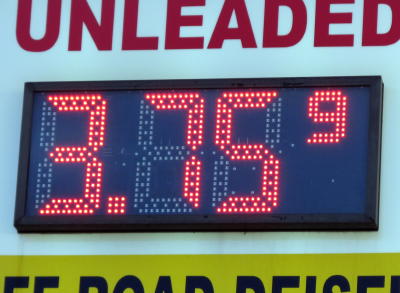ALERT: GASOLINE PRICES SOARING - Central WV Workers Pinched, US Heading Toward World Market Prices?

Calhoun gas sign indicates coming turmoil
READY YOURSELF TO MAKE PERMANENT CHANGES IN VEHICLES YOU OWN AND DRIVE AND YOUR DRIVING HABITS (UNLESS YOU ARE LOADED)AND WHERE YOU LIVE IN PROXIMITY TO WORK...
Americans are fretting about the price of gasoline, which has surged in West Virginia to about $3.75 a gallon in recent days.
The cost of gasoline in central West Virginia, where most people drive 80-150 miles a day to work, will put more than a crimp on workers to make a living for their family.
The cost per gallon is expected to top $4 and could even head toward $5, according to some analysts.
If that happens, central WV workers who travel will be devastated.
Officials are blaming the turmoil in oil-producing nations in the Middle East and North Africa, although there is little if any disruption so far with the oil supply.
Crude just increased to $108 a barrel, which likely means further increases.
America has remained an oil dependent economy for years, lacking far behind most developed nations with lower cost public transportation, those countries having shifted to fuel-efficient automobiles.
The price of gas in America lags far behind its European counterparts. While Americans tear their hair out at the pump, Europeans watch them enviously from across the Atlantic.
Most Europeans pay at least double what Americans do. Some of them, including the Greeks and the Scandinavians, shell out even more.
In Oslo, Sweden it's $9.28 per gallon.
Most Europeans, including the British, the Irish, the Germans, the Italians and the French, pay somewhere between $7.50 and $8.50 per gallon, according to the International Energy Administration.
Politicians often say that Europeans pay a lot for gas because they don't have their own source of fossil fuels.
In fact, they do.
Norway is awash in oil because of its thriving oil industry in the North Atlantic. The United Kingdom also has access to the oil fields in the same region.
Italy has deep corporate ties with Libya. Its oil production company, Eni, is the largest producer in Libya.
But even in the best of times, without civil war in Libya, gas in Italy is expensive when compared to the U.S.
Italians on average paid $7.77 a gallon at the end of February.
"The difference between countries comes down to taxes and subsidies," said Tom Kloza, the chief oil analyst for Oil Price Information Service.
"Prices are incredibly high in Europe because of the stiff taxes that EU countries put on fuel. The same holds true for many other countries."
The Japanese also pay more - $6.30 at the end of February, and that price is skyrocketing because of the recent earthquake.
Even the Canadians have been used to paying $4.50 a gallon.
In 2008, the average gas prices reached a peak of $4.11 in the U.S.
That same year gas was retailing for less than a dollar per gallon in Saudi Arabia, Egypt and Nigeria, according to research company AirInc.
In Venezuela that year, gas was selling for 12 cents a gallon, the low cost subsidized by the government.
Don't expect prices to soar in those countries. Subsidized gas prices are used as a means of controlling the population.
The high gas and oil prices surely will have a negative impact on a recovery for the current Great Recession, which will likely be with us for years to come.